|
|
|

|
| In a recent Sunday NY Times there was a magazine on travel and clothes, etc... on the cover there's a photo of an interesting looking row boat (with a fashion model in it, of course)... on page 88 there's another photo of the boat
(with the same young lady in it)... it appears to be a wooden skiff, and the photos show some kind of large reel, as if perhaps it is an actual work or fishing boat.. the shot appears to have been taken on a lake surrounded with snow-covered mountains... at my age I'm more intrested in the boat than the fashion model... just wondering if you or any of your readers might know what kind of boat it is and where the photo was taken.... Thanks, Tyson in Galveston - (click images below for larger views) |
|
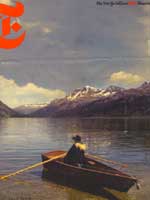
|
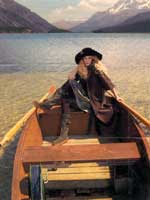 |
| 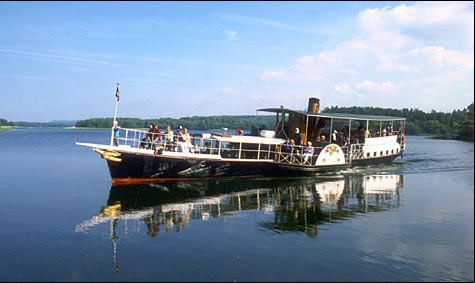
Hey Alistair,
The Esperanza, the beautiful steamboat from 1871, shown in your interesting article, has a still older sister in Denmark.
The “Hjejlen”, shown above, sailed her first trip in 1861, and is still active in the summer months, where it sails several times a day, in the beautiful lakes around Silkeborg, in the center of the Danish mainland. In fact it is the oldest “living” steam ship in the world.... and all it’s life it has sailed on these lakes! See https://www.hjejlen.com/ and choose English....
Regards, Groeten, Hasta la vista....
Maarten Bijl |
| |
|
I really enjoyed Lew Clayman's "Right on the Money" article. While Lew was concentrating on money in current curculation - and no doubt other current examples have come forward, there's the boat on the back of the Canadian one dollar bill (no longer in circulation) that most Canadians will remember if their memory banks are working. I've attached a picture of the bill and the boat along with some links about the boat which, by the way, is still around although now grounded permanently at the Canadian Museum of Civilization.
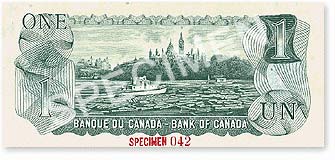
Bryant Owen
Woodview Ontario
Canada
See
https://www.civilization.ca/mce_ccm/cmmiseng.html
see also
https://www.stevebriggs.com/osmrm/ancasterhistory.html
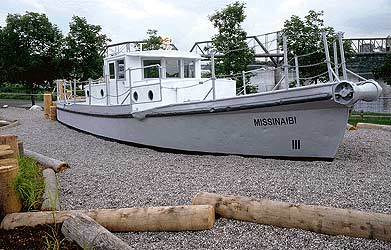
|
| |
|
Shop Glossary
(thanks to Chris Ostlind)
DRILL PRESS: A tall upright machine useful for suddenly snatching flat metal bar stock out of your hands so that it smacks you in the chest and flings your beer across the room, splattering it against that freshly painted airplane part you were drying.
WIRE WHEEL: Cleans paint off bolts and then throws them somewhere under the workbench with the speed of light. Also removes fingerprint whorls and hard-earned guitar calluses in about the time it takes you to say, "Ouch...."
ELECTRIC HAND DRILL: Normally used for spinning pop rivets in their holes until you die of old age.
PLIERS: Used to round off bolt heads.
HACKSAW: One of a family of cutting tools built on the Ouija board principle. It transforms human energy into a crooked, unpredictable motion, and the more you attempt to influence its course, the more dismal your future becomes.
VISE-GRIPS: Used to round off bolt heads. If nothing else is available, they can also be used to transfer intense welding heat to the palm of your hand.
OXYACETYLENE TORCH: Used almost entirely for lighting various flammable objects in your shop on fire. Also handy for igniting the grease inside the wheel hub you want the bearing race out of.
WHITWORTH SOCKETS: Once used for working on older British cars and motorcycles, they are now used mainly for impersonating that 9/16 or 1/2 socket you've been searching for the last 15 minutes.
HYDRAULIC FLOOR JACK: Used for lowering an automobile to the ground after you have installed your new disk brake pads, trapping the jack handle firmly under the bumper.
EIGHT-FOOT LONG DOUGLAS FIR 2X4: Used for levering an automobile upward off a hydraulic jack handle.
TWEEZERS: A tool for removing wood splinters.
PHONE: Tool for calling your neighbour to see if he has another hydraulic floor jack.
SNAP-ON GASKET SCRAPER: Theoretically useful as a sandwich tool for spreading mayonnaise; used mainly for getting dogdoo off your boot.
E-Z OUT BOLT AND STUD EXTRACTOR: A tool ten times harder than any known drill bit that snaps off in bolt holes you couldn’t use anyway.
TWO-TON ENGINE HOIST: A tool for testing the tensile strength on everything you forgot to disconnect.
CRAFTSMAN 1/2 x 16-INCH SCREWDRIVER: A large prybar that inexplicably has an accurately machined screwdriver tip on the end opposite the handle.
AVIATION METAL SNIPS: See hacksaw.
TROUBLE LIGHT: The home mechanic's own tanning booth. Sometimes called a drop light, it is a good source of vitamin D, "the sunshine vitamin," which is not otherwise found under cars at night. Health benefits aside, it's main purpose is to consume 40-watt light bulbs at about the same rate that 105-mm howitzer shells might be used during, say, the first few hours of the Battle of the Bulge. More often dark than light, its name is somewhat misleading.
PHILLIPS SCREWDRIVER: Normally used to stab the lids of old-style paper-and-tin oil cans and splash oil on your shirt; but can also be used, as the name implies, to strip out Phillips screw heads.
AIR COMPRESSOR: A machine that takes energy produced in a coal-burning power plant 200 miles away and transforms it into compressed air that travels by hose to a Chicago Pneumatic impact wrench that grips rusty bolts last over tightened 58 years ago by someone at ERCO, and neatly rounds off their heads.
PRY BAR: A tool used to crumple the metal surrounding that clip or bracket you needed to remove in order to replace a 50¢ part.
HOSE CUTTER: A tool used to cut hoses too short.
HAMMER: Originally employed as a weapon of war, the hammer nowadays is used as a kind of divining rod to locate the most expensive parts not far from the object we are trying to hit.
MECHANIC'S KNIFE: Used to open and slice through the contents of cardboard cartons delivered to your front door; works particularly well on contents such as seats, vinyl records, liquids in plastic bottles, collector magazines, refund checks, and rubber or plastic parts.
EXPLETIVE: A balm, usually applied verbally in hindsight, which somehow eases those pains and indignities following our every deficiency in foresight.
|
| |
|
There's something going on here, but you don't know what it is .....
do you Mr. Jones?
https://transat.equitenergie.free.fr/
Yikes!! It's the French! And they're coming ashore! - ChrisO

|
| |
Chuck,
I thought you might like to know that a certain hat was seen working at Stage 2 of this year's Greenbelt Arts Festival...
https://www.greenbelt.org.uk/)

Tis always good to combine hobbies :)
Cheers
Al |
| |
|
OK,
This represents a real problem, no matter how you look at it.
ChrisO
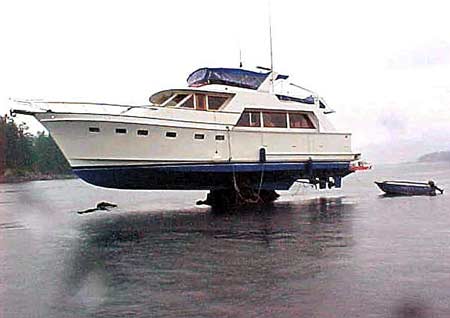
|
| |
|

Chesapeake Light Craft Fall Sale and Newsletter
At CLC, the arrival of cooler weather means two things: it's
time to think about a Winter boatbuilding project, and it's time for our
Fall kit sale.
That's right, take $75 off of boat kits from now
until midnight, November 1st. Here's the fine print: the Fall Kit Sale
applies to boat kits only. The CLC SailRig and sailing component kits are
excluded. May not be combined with other offers. If you order close to the
end of the sale, you may have to wait a few weeks to get your kit. Check
out www.clcboats.com to read more about it.
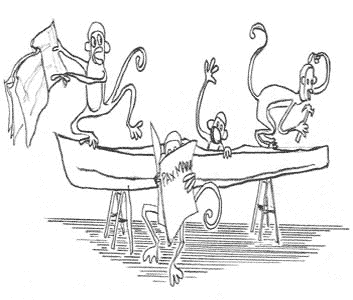
75 bucks will go a long
way towards covering shipping, so don't miss the boat!
At
www.clcboats.com you'll find the latest edition of Notes From Our Shop, with
articles about the new Shearwater line of sea kayaks, how to add veneer
inlays or "onlays" to the deck of your boat, new products like the Longbow
Greenland Paddle, and articles about a nonstop crossing of Lake Michigan
in kayaks and the adventure of building 22 boats in one weekend. If you're
up-to-date on our mailing list, you'll get a print copy in the
mail.
Chesapeake Light Craft, LLC,
1805 George Avenue, Annapolis, MD
21401
Tel (410) 267-0137 | Fax 24 hrs/day (410) 267-5689

© 1995-2005 Chesapeake Light Craft, LLC
|
| |
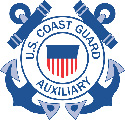 Date: Oct 14, 2005 Date: Oct 14, 2005
Contact: Aux.Rob Westcott
National Press Corps
Public Affairs Department
United States Coast Guard Auxiliary
https://www.auxpa.org
516-353-9155
Media@auxpa.org
Louisiana Flotilla Reaches Out To
Smallest Katrina and Rita Victims
 When the levees broke and
hundreds of Louisiana bayou children were displaced by the flood waters,
members of Flotilla 47 (Terrebonne Parrish, Louisiana) of the Coast Guard
Auxiliary Eighth District, Coastal Region, reached out to bring comfort
and encouragement to the youngsters and their families. When the levees broke and
hundreds of Louisiana bayou children were displaced by the flood waters,
members of Flotilla 47 (Terrebonne Parrish, Louisiana) of the Coast Guard
Auxiliary Eighth District, Coastal Region, reached out to bring comfort
and encouragement to the youngsters and their families.
Why, these children were asking, did the water come in and
flood their homes? Why couldn’t they go to school?
For this Flotilla, it was just a part of an ongoing focus of
reaching out to the children of the area.
Before Flotilla 47 got involved with the children of their
Parrish, twenty to thirty children drowned on the area waterways per year.
Thanks to the public education and safety patrol efforts of Flotilla 47,
the number dropped to zero for 2005, according to Flotilla member Joe
Thomisee.
Now, these children needed words of assurance, and something
to take their minds off of the two storms they had endured.
With 15,000 bayou residents displaced by Hurricane Rita, The
Civic Center at Houma, Louisiana became the hub of relief efforts in the
Parrish.
 On Saturday, October 1, Joe
and his wife, Ethel, also a Flotilla member, went to Civic Center with
hundreds of “Inky the Whale” and “Officer Snook” coloring books, along
with an ample supply of crayons donated by Disney at the request of
Flotilla 45 (Seventh Auxiliary Coast Guard District located in Sanford,
Florida), Commander Sue Smith, a Disney supervisor. On Saturday, October 1, Joe
and his wife, Ethel, also a Flotilla member, went to Civic Center with
hundreds of “Inky the Whale” and “Officer Snook” coloring books, along
with an ample supply of crayons donated by Disney at the request of
Flotilla 45 (Seventh Auxiliary Coast Guard District located in Sanford,
Florida), Commander Sue Smith, a Disney supervisor.
While the coloring books and crayons were eagerly snapped up
by the children, that was only the beginning.
Auxiliarist Ethel Thomisee quickly became “Ma” to children
looking for grandmotherly comfort. Joe, likewise, became “Pa.”. Native
American kids, Cajun kids, kids of every race and creed reached out to
these caring Auxiliarists and found comfort in their reassuring words and
hugs.
As many families had returned to the bayous to begin the
recovery and rebuilding process, this initial effort was just the start of
Flotilla 47’s efforts to reach out to hundreds of Parrish children.
Flotilla 47 members plan on bringing “Officer Snook” and “Inky” to
children in area Head Start and kindergarten programs, and through the
generosity of the Auxiliary National Supply Center (and its Director,
Randy Ernst) and the Disney Company (through Flotilla 45), there will be
plenty of materials available.
In the aftermath of Katrina and Rita, such non-traditional
Auxiliary efforts are making a real difference in the storm-ravaged
communities. “Ma” and “Pa” have reported for duty!
*****
The United States Coast
Guard Auxiliary is composed of uniformed, non-military volunteer's who assist the Coast Guard in all of its
varied missions, except for military and direct law enforcement. These men and
women can be found on the nation's waterways, in the air, in classrooms and on
the dock, performing Maritime Domain Awareness patrols, safety patrols, vessel
safety checks and public education.
The United States Coast Guard Auxiliary was founded in 1939 by an Act of
Congress as the U.S. Coast Guard Reserve and re-designated as the Auxiliary in
1941. Its 31,000 members donate millions of hours
annually in support of Coast Guard missions.
|
| |
|
|

